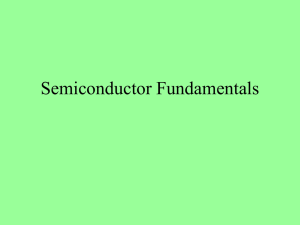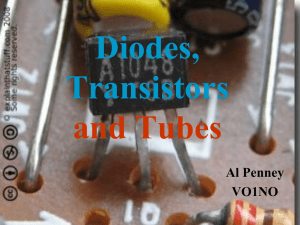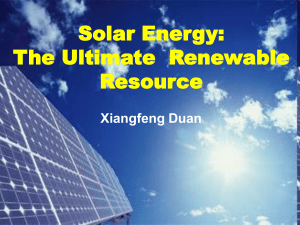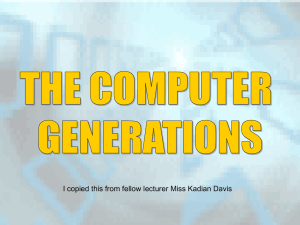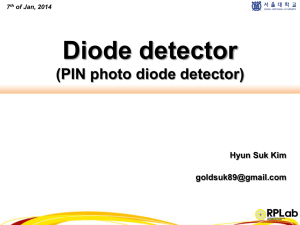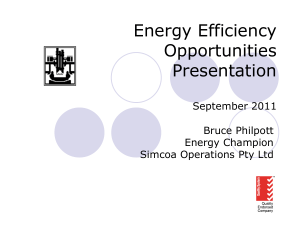2. Introduction to Semiconductors
advertisement
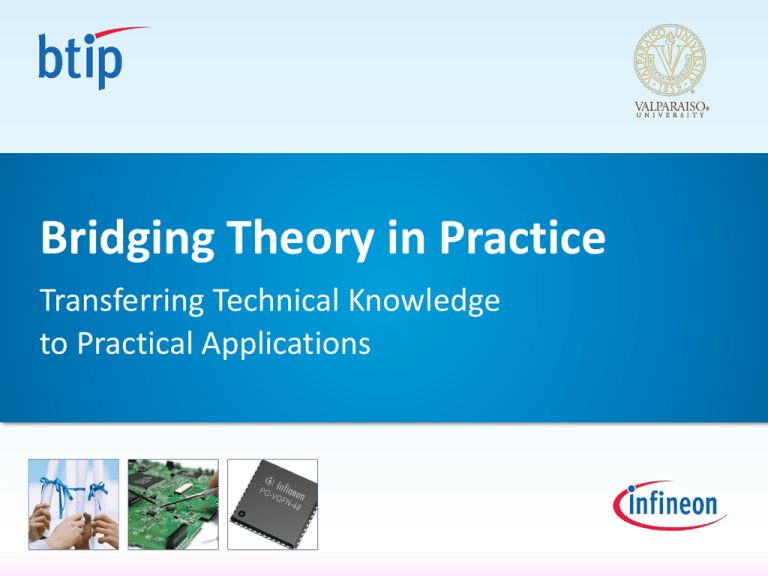
Bridging Theory in Practice Transferring Technical Knowledge to Practical Applications Introduction to Semiconductors Introduction to Semiconductors C B D G E S Introduction to Semiconductors Intended Audience: • Engineers with little or no semiconductor background • A basic understanding of electricity is assumed Topics Covered: • • • • What is a semiconductor? What is a diode? What is a bipolar transistor? What is a MOSFET transistor? Expected Time: • Approximately 1 Hour Introduction to Semiconductors • • • • • What is a Semiconductor? What is a N-Type and a P-Type Semiconductor? What is a Diode? What is a Bipolar Junction Transistor (BJT)? What is a Field Effect Transistor (MOSFET)? Silicon Crystal Structure – – – – – – – – • A crystal is a solid composed of atoms in a single, UNIFIED array • Notice each silicon atom is “connected” to its four nearest neighboring silicon atoms – – – – – – – – – Si – Si – Si – Si –– Si – Si – Si – Si – – – – – – – – – – Si – Si – Si – Si –– Si – Si – Si – Si – – – – – – – – – – – – – – – – – – Si – Si – Si – Si –– Si – Si – Si – Si – – Si – Si – Si – Si –– Si – Si – Si – Si – Sharing Electrons • Many atoms (including silicon) like to have EIGHT electrons in their outer “orbit” • But, silicon only has FOUR outer electrons • Solution: Silicon atoms share electrons with each other Silicon Atoms Sharing Electrons in a Crystal Si Si Si Si Si Si Si Si Si Si Si Si Si Si Si Si Si Si Si Si Si Si Si Si Si Si Si Si Si Si Si Si Si Si Si Si Si Si Si Si Si Si Si Si Si Si Si Si Si Si Si Si Si Si Si Si Si Si Si Si Si Si Si Si Si Si Si Si Si Si Si Si Si Si Si Si Si Semiconductor Silicon • A conductor is a material which “conducts” electricity easily (such as metals) • An insulator is a material which is a very poor conductor of electricity (such as glass) • A semiconductor (silicon) is a material which acts like an insulator, but behaves like a conductor when it is combined with other materials Introduction to Semiconductors • • • • • What is a Semiconductor? What is a N-Type and a P-Type Semiconductor? What is a Diode? What is a Bipolar Junction Transistor (BJT)? What is a Field Effect Transistor (MOSFET)? N-Type Silicon Charge Neutrality • Adding Phosphorous to silicon creates a semiconductor with additional mobile Negative charges (electrons) Phosphorous Phosphorous added to Silicon +5 +5 Plus 1 Mobile Electron (-) P-Type Silicon Charge Neutrality • Adding boron to silicon creates a semiconductor with additional mobile Positive charges (absence of electrons) Boron Boron added to Silicon +3 +3 Plus 1 Mobile Hole (+) Boron and Phosphorous Atoms in a "Sea of Silicon" Boron Phosphorous Introduction to Semiconductors • • • • • What is a Semiconductor? What is a N-Type and a P-Type Semiconductor? What is a Diode? What is a Bipolar Junction Transistor (BJT)? What is a Field Effect Transistor (MOSFET)? Boron and Phosphorous Mobile Charge in a Sea of Silicon Boron Phosphorous Boron and Phosphorous Mobile Charge in a Sea of Silicon Boron Diffusing positive charge leaves behind a stationary negative charge Boron and Phosphorous Mobile Charge in a Sea of Silicon Boron Diffusing negative charge leaves behind a stationary positive charge Phosphorous Boron and Phosphorous Mobile Charge in a Sea of Silicon Boron Phosphorous Diode Under Forward Bias • Before the forward bias is applied… Positive P Electrons Negative Holes "Built In Voltage" ~ 0.7V N Diode Under Forward Bias P Positive + Negative • As the forward bias is applied, it overcomes the built in voltage and current can flow.... "Built In Voltage" ~ 0.0V 0.7V 0.6V 0.5V 0.4V 0.3V 0.2V 0.1V 0.0V 0.7V 0.6V 0.5V 0.4V 0.3V 0.2V 0.1V N - Diode Under Forward Bias • As the forward bias is applied, it overcomes the built in voltage and current can flow.... + P N "Built In Voltage" ~ 0.0V 0.7V - Diode Under Forward Bias Current (I) • As the forward bias is applied, it overcomes the built in voltage and current can flow.... ~0.7 Voltage (V) Diode Under Reverse Bias • Before the reverse bias is applied… Positive P Electrons Negative Holes "Built In Voltage" ~ 0.7V N Diode Under Reverse Bias • As reverse bias is applied… P Positive - Electrons Negative Holes "Built In Voltage" ~ 1.7V 1.0V N + Diode Under Reverse Bias • As reverse bias is applied… P Positive - Electrons Negative Holes N "Built In Voltage" ~ 1.7V 1.0V + P Positive Negative Ideal Diode Current-Voltage (I-V) Characteristics N Current (I) V Voltage (V) 0.7 Ideal Current (I) Actual Diode Current-Voltage (I-V) Characteristics 0.7 Actual Voltage (V) Diode I-V Temperature Characteristics Current (I) +125C +25C -40C -40C 0.7 +25C +125C Voltage (V) Introduction to Semiconductors • • • • • What Is a Semiconductor? What is a N-Type and a P-Type Semiconductor? What is a Diode? What is a Bipolar Junction Transistor (BJT)? What is a Field Effect Transistor (MOSFET)? Bipolar Junction Transistor (BJT) Positive P Negative Negative N Positive • Formed by back-to-back n-type and p-type semiconductor regions P-type region is very narrow N NPN Bipolar Junction Transistor (BJT) Collector (will collect electrons) N Base (of operations, i.e. the control center) Positive Negative P Negative Positive N Emitter (will emit electrons) NPN Bipolar Junction Transistor (BJT) Collector VCollector > VBase N Positive Negative Base Current tries to flow P Negative Positive N Emitter VCE Reverse Biased No Current Flows NPN Bipolar Junction Transistor (BJT) Collector N VBase > VEmitter Base VBE VCE Positive Negative P Negative Positive N Emitter Forward Biased Current Can Flow NPN Bipolar Junction Transistor (BJT) We now have an excessively large number of electrons in the base. VBase > VEmitter Base VBE Collector N VCE Positive Negative P Negative Positive Current Flows Electrons near basecollector interface are pulled across creating a current. N Emitter Forward Biased Current Can Flow NPN Bipolar Junction Transistor (BJT) Collector (will collect electrons) N Base (of operations, i.e. the control center) C Positive Negative B P Negative Positive E N Emitter (will emit electrons) Bipolar Junction Transistor (BJT) Invented in 1947 by: William Shockley (1910-1989) Walter Brattain (1902-1987) John Bardeen (1908-1991) • “Point contact” transistor used a single physical contact as the base • Consisted of a germanium crystal and two “whiskers” Introduction to Semiconductors • • • • • What Is a Semiconductor? What is a N-Type and a P-Type Semiconductor? What is a Diode? What is a Bipolar Junction Transistor (BJT)? What is a Field Effect Transistor (MOSFET)? Metal Oxide Semiconductor Field Effect Transistor (MOSFET) True of False: The transistor was first conceived and patented by W.Shockley, J.Bardeen, and W.Brattain at Bell Labs in the late 1940’s… Metal Oxide Semiconductor Field Effect Transistor (MOSFET) FALSE! The concept of a field effect transistor was first developed and patented by J.Lilienfeld in Canada and the United States in the years 1924-1928. In fact, the Bell Labs engineers’ first patent was written to reflect Lilienfeld’s prior work. n-Channel MOSFET Cross Section (nMOS) “Sea of Silicon with Mobile Holes” P-Type Silicon Substrate n-Channel MOSFET Cross Section (nMOS) SiO2 (An Excellent Insulator) P-Type Silicon Substrate n-Channel MOSFET Cross Section (nMOS) N-Type Silicon “Sea of Silicon with Mobile Electrons” SiO2 N-Type Si N-Type Si P-Type Silicon Substrate n-Channel MOSFET Cross Section (nMOS) Metal Contacts SiO2 N-Type Si N-Type Si P-Type Silicon Substrate n-Channel MOSFET Cross Section (nMOS) “Gate” (or Door) between Electrons will come source and drain from here Source Gate Electrons will Drain come out out here SiO2 N-Type Si N-Type Si P-Type Silicon Substrate n-Channel MOSFET Cross Section (nMOS) Source Gate Drain SiO2 N-Type Si N-Type Si P-Type Silicon Substrate Gate Source Drain n-Channel MOSFET Biasing Source Gate Drain SiO2 N-Type Si N-Type Si P-Type Silicon Substrate Back-to-Back Diodes n-Channel MOSFET Biasing Current wants to flow Source Gate = 0V Drain SiO2 N-Type Si N-Type Si Reverse Bias No Current Flows P-Type Silicon Substrate n-Channel MOSFET Mobile Carriers • Above 0 degK, a few mobile electrons will exist in the substrate Source Gate Drain SiO2 N-Type Si N-Type Si P-Type Silicon Substrate Diodes Still Exist n-Channel MOSFET Biasing Source Gate > 0V Drain SiO2 N-Type Si N-Type Si P-Type Silicon Substrate n-Channel MOSFET Biasing Current Flows Source Gate > 0V Drain SiO2 N-Type Si N-Type Si P-Type Silicon Substrate Introduction to Semiconductors • • • • • What Is a Semiconductor? What is a N-Type and a P-Type Semiconductor? What is a Diode? What is a Bipolar Junction Transistor (BJT)? What is a Field Effect Transistor (MOSFET)? Introduction to Semiconductors C B D G E S Thank you! www.btipnow.com
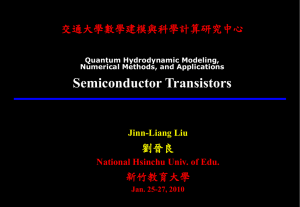
![Semiconductor Theory and LEDs []](http://s2.studylib.net/store/data/005344282_1-002e940341a06a118163153cc1e4e06f-300x300.png)
